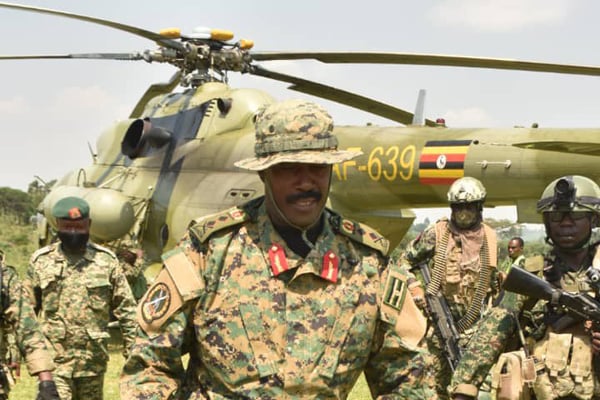Prime
The key questions UPDF mission hasn’t answered

Maj Gen Kayanja Muhanga, the head of Operation Shujja
What you need to know:
- On November 30, the UPDF marched into the DR Congo through the small border town of Lamia in Bundibugyo. After six weeks of sustained bombing and counter-guerilla operations in the dense forests of North Kivu, Raymond Mujuni has been granted access to the war frontline embedded with the UPDF. This is the last of a three part series of the UPDF’s war in the eastern DR Congo.
From the military warplanes looking down from a small belt of River Semliki snakes through a dence forest making its way from the Lake Edward in Beni and pouring into Lake Albert on the Ugandan side.
It is one of the most iconic geographical features that parts Uganda from the Eastern DR Congo. On the one hand are flat lands with developing settlements – and on the other thick forests with occasional chipping birds.
In 1884, a conference in Berlin had demarcated a fine line of 475 miles and granted the Uganda side to the British protectorate whilst the Congolese side fell into the hands of a heinous murderer and genocidal King Leopold II.
He administered the Congo with a rough iron fist, ironically calling it the Congo Free State. In his reign, native populations were massacred enmasse, enslaved and dominated. Under his rubber quotas, Congolese natives were required to submit to his soldiers rubber quotas, which when not met, led to immediate slaughter.
It’s easy to chalk it off as history, but the living population in this area today is only two generations detached from that legacy. None of the leaders of the DR Congo after Leopold cared as much about the Eastern DR Congo. It appeared on the cartographic maps but local administrative units barely reached.
To fill this void, small militias rose to protect civilian populations and quickly morphed into private armies that collected taxes, manned cobalt and gold mines, dominated the timber trade and, in some cases, entered into agreements with the Kinshasa government.
But Congo’s neighbours added to the rebel populations. When, for example, the Rwandan Patriotic Front (RPF) beat back genocidal militias, they retreated into the South Kivu and mobilised there, and when Uganda, in the 2000s beat back the Allied Democratic Forces (ADF) rebels, they retreated into the North Kivu and Ituri forests. The lack of a central control and strong government in DR Congo made easier for the groups to survive, rebuild and flourish.

UPDF soldiers receive food supplies in the jungles of DR Congo. Photo / Courtesy
The Uganda People’s Defence Forces (UPDF) had last engaged the ADF in combat in 2007, then pushing the group into a ceasefire negotiation and eventual fleeing into the DR Congo. They now were returning 14 years later to a changed ADF, where the group initially fought with conventional warfare, now asymmetrical warfare that placed radical recruitment and explosion of bombs at the centre of the battle strategy. Where previously the ADF moved in large groups through the Semliki park, now the group moved in smaller fragmented factions that could operate independently without central authority.
Where the UPDF had built an understanding of Jamil Mukulu, the then leader, they now had to relearn the ways of his junior Musa Baluku, and where previously the ADF had no international connections, it now was acknowledged in its bomb campaigns by established terror groups like Islamic State.
All these contradictions lay out prominently in the dense forests where we trekked for long with soldiers looking for ADF camps.
Mission
Would the UPDF find the ADF militants in the forests? If they did, what faction would they be meeting? If they didn’t, what would be the purpose of their mission? Are the bombed camps former colonies of ADF? If they are, what shows? If they aren’t, then who runs them? More importantly, what battle strategy would help the UPDF achieve their mission in the tight guidelines provided by their host DR Congo?
Those questions could also be heard back home in places as high as the national Parliament;
“How will the UPDF avoid fighting other groups that aren’t ADF? And how will they even confirm which group they are firing at?” Ibrahim Semujju Nganda asked in an interview in his office on the Parliament fourth floor.
“These are questions we need immediate answers to” he adds.
But even in Uganda’s civil society, the sense of questions remained present. Godber Tumushabe, an analyst and leader at Great Lakes Institute For Strategic Studies asked; “When will the UPDF know that the war is over? When do they come home?”
Dismas Nkunda, an analyst and former journalist that covered wars in the DR Congo, asked: “How will the UPDF avoid getting entagled in the riches that Congo provides?”, “How” he also asked “will the army avoid getting sucked into a confrontation with other countries that have interests in DR Congo”
It looked, by the time our embed was over in DR Congo with the UPDF, we had gathered a lot more questions that we could possibly get answers to – questions that for now, rested firmly at the boardroom of Uganda’s Commander in Chief, Yoweri Kaguta Museveni.




